Best Practices for System Commissioning and Training for Repeat Business
The following insight was excerpted from a feature story about Best Practices in SCN’s October 2016 print edition.
We have probably all been guilty of doing some of our best work on a project only to have it fall apart at the end, because we do not finish strong through the training of the customer. This resonated with me a few years back as I witnessed inconsistent training experiences, depending not only on the region, but based on who delivered the training and to what type of group on the customer’s end.
Then one day I was interviewing someone and heard a story about how someone was ripping out all that technology Whitlock had installed not that long ago. “It was over-engineered,” they said. In reality, Whitlock had done a very poor job of ensuring the vision for the technology, from the initial scope development transferred to training at the end and driving adoption.
This can be tricky for an integrator to address as at times — one customer group has a vision and a budget, and another takes over the space and maintenance. It is our role to ensure the vision meets adoption, and that adoption can be measured.
We took over our training initiatives at a national level and created Whitlock technology adoption services (TAS). The goals were two-fold: First, to ensure more consistent and professional training plans and best practices were used by Whitlock on a national and global level. The bigger goal was to rethink how we developed a scope and bill of materials for the customer. Our enterprise delivery model starts with “align with customer vision.” Shortly thereafter is “ensure adoption.” So for Whitlock, it was not only about creating a better training experience, introducing some cool and innovative adoption and training ideas, tools, and reporting, it was about retraining sales, technical operations, and managed services on how to measure project success:
- Have we met the goals for technology adoption that our customer envisioned?
- Are we helping them measure adoption?
- Are we using our stewardship meetings to provide adoption analysis, bring innovation, and share trends around technology adoption?
As Whitlock’s enterprise delivery model evolved, nationally and globally, and we have become better at providing a more consistent user experience across our customer’s enterprise through standards, we recognized that system commissioning can definitely have some standard processes, but an element of familiarity with the customer and their environment exists that benefits from familiar high-end resources being assigned to those customers. Through our Enterprise Resource Group and a tweak to our enterprise delivery model, we have used local resources to scale and provide consistency through defined room and installations standards, drawings, programming, etc., but assigned dedicated enterprise quality assurance resources to ensure that the testing, commissioning, and training is consistent and we are not learning previous lessons learned in front of our customer.
To further emphasize the need for this, we found our customers had already developed this best practice and have their own internal resources going from site to site to ensure the testing and commissioning process is efficient and consistent.
A daily selection of features, industry news, and analysis for AV/IT professionals. Sign up below.
The last thing Whitlock can continue to do is put a different resource in front of them for each location. To continue our “big picture” focus of making sure everything scales, we have trained redundant quality assurance resources on our large enterprise customers and additionally invested in East, Central, and West Coast resources for efficiency.
